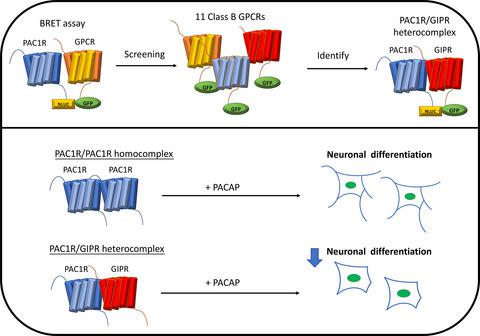当前位置:
X-MOL 学术
›
J. Neurochem.
›
论文详情
Our official English website, www.x-mol.net, welcomes your feedback! (Note: you will need to create a separate account there.)
GIP receptor suppresses PAC1receptor-mediated neuronal differentiation via formation of a receptor heterocomplex
Journal of Neurochemistry ( IF 4.7 ) Pub Date : 2020-10-20 , DOI: 10.1111/jnc.15220 Ran Ke 1 , Samson I S Lok 1 , Kailash Singh 2 , Billy K C Chow 2 , Leo T O Lee 1, 3
Journal of Neurochemistry ( IF 4.7 ) Pub Date : 2020-10-20 , DOI: 10.1111/jnc.15220 Ran Ke 1 , Samson I S Lok 1 , Kailash Singh 2 , Billy K C Chow 2 , Leo T O Lee 1, 3
Affiliation

|
Pituitary adenylate cyclase-activating peptide (PACAP) receptor (PAC1R) is a class B Gprotein-coupled receptor (GPCR) that is widely expressed in the human body and is involved in neuronal differentiation. As class B GPCRs are known to form heterocomplexes with family members, we hypothesized that PAC1R mediates neuronal differentiation through interaction with a class B GPCR. We used the BRET assay to identify potential interactions between PAC1R and 11 class B GPCRs. Gastric inhibitory polypeptide receptor (GIPR) and secretin receptor were identified as putative binding partners of PAC1R. The effect of heterocomplex formation by PAC1R on receptor activation was evaluated with the cyclic (c)AMP, luciferase reporter, and calcium signaling assays; and the effects on receptor internalization and subcellular localization were examined by confocal microscopy. The results suggested he PAC1R/GIPR heterocomplex suppressed signaling events downstream of PAC1R, including cAMP production, serum response element and calcium signaling, and β-arrestin recruitment. Protein–protein interaction was analyzed in silico, and induction of neuronal differentiation by the PAC1R heterocomplex was assessed in SH-SY5Y neuronal cells by measure the morphological changes and marker genes expression by real-time quantitative PCR and western blot. Over-expression of GIPR suppressed PACAP/PAC1R-mediated neuronal differentiation and the differentiation markers expression in SH-SY5Y cells. GIPR regulates neuronal differentiation through heterocomplex formation with PAC1R.
中文翻译:

GIP 受体通过形成受体异源复合物抑制 PAC1 受体介导的神经元分化
垂体腺苷酸环化酶激活肽 (PACAP) 受体 (PAC1R) 是 B 类 G 蛋白偶联受体 (GPCR),在人体内广泛表达并参与神经元分化。由于已知 B 类 GPCR 与家族成员形成异源复合物,我们假设 PAC1R 通过与 B 类 GPCR 相互作用介导神经元分化。我们使用 BRET 测定来确定 PAC1R 和 11 个 B 类 GPCR 之间的潜在相互作用。胃抑制多肽受体 (GIPR) 和促胰液素受体被确定为 PAC1R 的假定结合伙伴。PAC1R 形成的异源复合物对受体激活的影响用环 (c)AMP、荧光素酶报告基因和钙信号分析进行评估;通过共聚焦显微镜检查对受体内化和亚细胞定位的影响。结果表明 PAC1R/GIPR 异源复合物抑制了 PAC1R 下游的信号事件,包括 cAMP 产生、血清反应元件和钙信号传导以及 β-抑制蛋白募集。在计算机上分析蛋白质-蛋白质相互作用,并通过实时定量 PCR 和蛋白质印迹测量形态变化和标记基因表达来评估 PAC1R 异源复合物在 SH-SY5Y 神经元细胞中对神经元分化的诱导。GIPR 的过度表达抑制了 SH-SY5Y 细胞中 PACAP/PAC1R 介导的神经元分化和分化标志物的表达。GIPR 通过与 PAC1R 形成异源复合物来调节神经元分化。结果表明 PAC1R/GIPR 异源复合物抑制了 PAC1R 下游的信号事件,包括 cAMP 产生、血清反应元件和钙信号传导以及 β-抑制蛋白募集。在计算机上分析蛋白质-蛋白质相互作用,并通过实时定量 PCR 和蛋白质印迹测量形态变化和标记基因表达来评估 PAC1R 异源复合物在 SH-SY5Y 神经元细胞中对神经元分化的诱导。GIPR 的过度表达抑制了 SH-SY5Y 细胞中 PACAP/PAC1R 介导的神经元分化和分化标志物的表达。GIPR 通过与 PAC1R 形成异源复合物来调节神经元分化。结果表明 PAC1R/GIPR 异源复合物抑制了 PAC1R 下游的信号事件,包括 cAMP 产生、血清反应元件和钙信号传导以及 β-抑制蛋白募集。在计算机上分析蛋白质-蛋白质相互作用,并通过实时定量 PCR 和蛋白质印迹测量形态变化和标记基因表达来评估 PAC1R 异源复合物在 SH-SY5Y 神经元细胞中对神经元分化的诱导。GIPR 的过度表达抑制了 SH-SY5Y 细胞中 PACAP/PAC1R 介导的神经元分化和分化标志物的表达。GIPR 通过与 PAC1R 形成异源复合物来调节神经元分化。在计算机上分析蛋白质-蛋白质相互作用,并通过实时定量 PCR 和蛋白质印迹测量形态变化和标记基因表达来评估 PAC1R 异源复合物在 SH-SY5Y 神经元细胞中对神经元分化的诱导。GIPR 的过度表达抑制了 SH-SY5Y 细胞中 PACAP/PAC1R 介导的神经元分化和分化标志物的表达。GIPR 通过与 PAC1R 形成异源复合物来调节神经元分化。在计算机上分析蛋白质-蛋白质相互作用,并通过实时定量 PCR 和蛋白质印迹测量形态变化和标记基因表达来评估 PAC1R 异源复合物在 SH-SY5Y 神经元细胞中对神经元分化的诱导。GIPR 的过度表达抑制了 SH-SY5Y 细胞中 PACAP/PAC1R 介导的神经元分化和分化标志物的表达。GIPR 通过与 PAC1R 形成异源复合物来调节神经元分化。GIPR 的过度表达抑制了 SH-SY5Y 细胞中 PACAP/PAC1R 介导的神经元分化和分化标志物的表达。GIPR 通过与 PAC1R 形成异源复合物来调节神经元分化。GIPR 的过度表达抑制了 SH-SY5Y 细胞中 PACAP/PAC1R 介导的神经元分化和分化标志物的表达。GIPR 通过与 PAC1R 形成异源复合物来调节神经元分化。
更新日期:2020-10-20
中文翻译:

GIP 受体通过形成受体异源复合物抑制 PAC1 受体介导的神经元分化
垂体腺苷酸环化酶激活肽 (PACAP) 受体 (PAC1R) 是 B 类 G 蛋白偶联受体 (GPCR),在人体内广泛表达并参与神经元分化。由于已知 B 类 GPCR 与家族成员形成异源复合物,我们假设 PAC1R 通过与 B 类 GPCR 相互作用介导神经元分化。我们使用 BRET 测定来确定 PAC1R 和 11 个 B 类 GPCR 之间的潜在相互作用。胃抑制多肽受体 (GIPR) 和促胰液素受体被确定为 PAC1R 的假定结合伙伴。PAC1R 形成的异源复合物对受体激活的影响用环 (c)AMP、荧光素酶报告基因和钙信号分析进行评估;通过共聚焦显微镜检查对受体内化和亚细胞定位的影响。结果表明 PAC1R/GIPR 异源复合物抑制了 PAC1R 下游的信号事件,包括 cAMP 产生、血清反应元件和钙信号传导以及 β-抑制蛋白募集。在计算机上分析蛋白质-蛋白质相互作用,并通过实时定量 PCR 和蛋白质印迹测量形态变化和标记基因表达来评估 PAC1R 异源复合物在 SH-SY5Y 神经元细胞中对神经元分化的诱导。GIPR 的过度表达抑制了 SH-SY5Y 细胞中 PACAP/PAC1R 介导的神经元分化和分化标志物的表达。GIPR 通过与 PAC1R 形成异源复合物来调节神经元分化。结果表明 PAC1R/GIPR 异源复合物抑制了 PAC1R 下游的信号事件,包括 cAMP 产生、血清反应元件和钙信号传导以及 β-抑制蛋白募集。在计算机上分析蛋白质-蛋白质相互作用,并通过实时定量 PCR 和蛋白质印迹测量形态变化和标记基因表达来评估 PAC1R 异源复合物在 SH-SY5Y 神经元细胞中对神经元分化的诱导。GIPR 的过度表达抑制了 SH-SY5Y 细胞中 PACAP/PAC1R 介导的神经元分化和分化标志物的表达。GIPR 通过与 PAC1R 形成异源复合物来调节神经元分化。结果表明 PAC1R/GIPR 异源复合物抑制了 PAC1R 下游的信号事件,包括 cAMP 产生、血清反应元件和钙信号传导以及 β-抑制蛋白募集。在计算机上分析蛋白质-蛋白质相互作用,并通过实时定量 PCR 和蛋白质印迹测量形态变化和标记基因表达来评估 PAC1R 异源复合物在 SH-SY5Y 神经元细胞中对神经元分化的诱导。GIPR 的过度表达抑制了 SH-SY5Y 细胞中 PACAP/PAC1R 介导的神经元分化和分化标志物的表达。GIPR 通过与 PAC1R 形成异源复合物来调节神经元分化。在计算机上分析蛋白质-蛋白质相互作用,并通过实时定量 PCR 和蛋白质印迹测量形态变化和标记基因表达来评估 PAC1R 异源复合物在 SH-SY5Y 神经元细胞中对神经元分化的诱导。GIPR 的过度表达抑制了 SH-SY5Y 细胞中 PACAP/PAC1R 介导的神经元分化和分化标志物的表达。GIPR 通过与 PAC1R 形成异源复合物来调节神经元分化。在计算机上分析蛋白质-蛋白质相互作用,并通过实时定量 PCR 和蛋白质印迹测量形态变化和标记基因表达来评估 PAC1R 异源复合物在 SH-SY5Y 神经元细胞中对神经元分化的诱导。GIPR 的过度表达抑制了 SH-SY5Y 细胞中 PACAP/PAC1R 介导的神经元分化和分化标志物的表达。GIPR 通过与 PAC1R 形成异源复合物来调节神经元分化。GIPR 的过度表达抑制了 SH-SY5Y 细胞中 PACAP/PAC1R 介导的神经元分化和分化标志物的表达。GIPR 通过与 PAC1R 形成异源复合物来调节神经元分化。GIPR 的过度表达抑制了 SH-SY5Y 细胞中 PACAP/PAC1R 介导的神经元分化和分化标志物的表达。GIPR 通过与 PAC1R 形成异源复合物来调节神经元分化。


























 京公网安备 11010802027423号
京公网安备 11010802027423号